Table of contents
- The history of the motorcycle Essay on motorcycle history
- The beginnings: around 1900 to 1914
- Laurin built in 1899 & Klement in Bohemia the first motorcycles
- Motorcycle construction emerged in a wide variety of industries
- The velocipede was a sensation in the country
- The second wave: 1918 to 1939
- The Nurburgring was inaugurated in 1927
- The number of motorcycles exceeded that of passenger cars
- The motorcycle industry came to a standstill in 1939
- After 1945
- Better a Volkswagen than a motorcycle
- Technical complexity at West German manufacturers
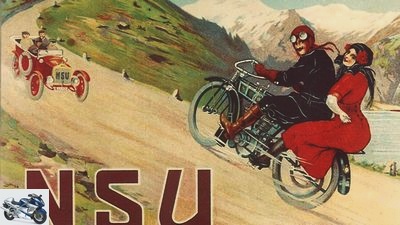
NSU / Audi
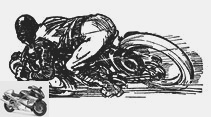

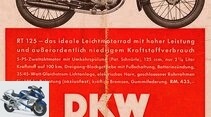
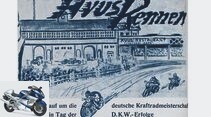
11 pictures
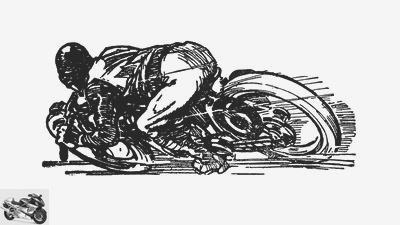
simplicissimus.info
1/11
The history of the motorcycle began around 1900.

BMW
2/11
In the deepest valley of the motorcycle population, the post-war generations found a new passion for motorcycles.

archive
3/11
An advertisement from 1940: The DKW RT 125 was fully developed, it was initially only used in the service of the Wehrmacht.
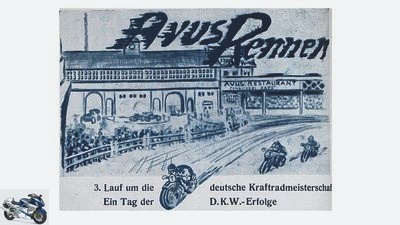
cutter
4/11
… and two legendary racetracks from that time.

cutter
5/11
Representing the enthusiasm for racing in the 1920s…

archive
6/11
In the course of the 1920s, “Das Motorrad” changed from an engineering magazine to a general-interest magazine.
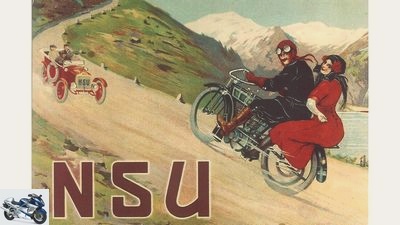
NSU
7/11
One of the rare motifs in which a manufacturer’s car and motorcycle meet in the same picture: NSU advertising 1913.
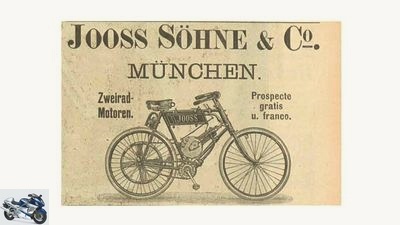
simplicissimus.info
8/11
Jooss Sons was a lesser known manufacturer of built-in motors.
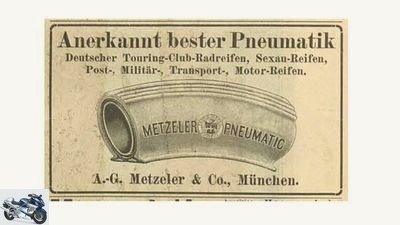
simplicissimus.info
9/11
In 1903 Metzeler was still building tubular tires with a bead.
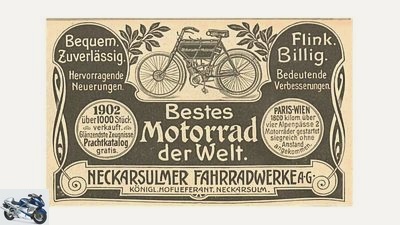
simplicissimus.info
10/11
An advertisement from the “Radel-Nummer” of the satirical magazine “Simplicissimus” from 1903: NSU was already producing on a large scale.
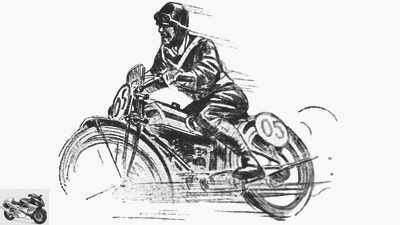
simplicissimus.info
11/11
What would we be without our bikes.
counselor
traffic & business
Motorcycle history
The history of the motorcycle
Essay on motorcycle history
What gave people the idea of building and driving motorcycles around 1900? How did the following generations develop this idea further? Trying to answer.
Ralf Schneider
07/29/2013
The beginnings: around 1900 to 1914
It didn’t start with the Daimler riding car from 1885. On the one hand, Pierre Michaud and Louis-Guillaume Perreaux had their steam bike running as early as 1869, and on the other, Gottlieb Daimler’s subframe did not understand the principle of the motorcycle anyway. Was the Hildebrand and Wolfmuller from 1894, the world’s first series motorcycle, at the beginning of motorcycle history? You can specify it that way if you need an exact start date. The actual story is not told, because the motorcycle did not really ignite until around 1900, worldwide.
Buy complete article

The history of the motorcycle
Essay on motorcycle history
8 pages) as PDF
€ 2.00
Buy now
Laurin built in 1899 & Klement in Bohemia the first motorcycles
Laurin built in 1899 & Klement in Bohemia the first motorcycles, in 1901 the Belgian Fabrique Nationale d’Armes de Guerre, or FN for short, began producing motorcycles, as did the Indian Motorcycle Company in Springfield / USA and Royal Enfield in Redditch, UK. In addition, Adler and the company NSU, founded as “Neckarsulmer Strickmaschinen Fabrik”, not to forget Opel in Russelsheim and Brennabor in Brandenburg an der Havel. Triumph in Coventry, UK, BSA in Birmingham and Wanderer in Chemnitz, Saxony, followed in 1902. In 1903 Harley-Davidson in Milwaukee, Victoria in Nuremberg and, after FN, Royal Enfield and BSA, another traditional arms manufacturer, the Husqvarna company in the eponymous Swedish city, started building motorcycles.
As early as spring 1903, in issue three of the satirical magazine “Simplicissimus”, the “Radel-Nummer”, the Neckarsulmer Fahrradwerke advertised with the slogan “Best motorcycle in the world” and claimed to have sold over 1000 motorcycles the year before. In addition, Corona advertised as a manufacturer of bicycles and motorcycles, Jooss Sons & Co. advertised their two-wheel motors, Durkopp for bicycles, motorcycles, motor vehicles and sewing machines, Brennabor for motorcycles and Continental, Dunlop and Metzeler for their “pneumatic” products. The “predecessor organization of the ADAC, the” German Motorcyclists Association “DMV, was founded in Stuttgart, and in October of the same year a magazine appeared in Germany for the first time that was specifically devoted to the emerging new means of transport:” Das Motorrad “.
Motorcycle construction emerged in a wide variety of industries
The above list of motorcycle pioneers is confusing, but far from complete. Because De Dion in France and Zedel in Switzerland, to name just two, supplied small, light engines that were suitable for installation in modified bicycle frames, and thus supplied an almost unmanageable number of other motorcycle manufacturers. If one asks about the reasons for this in-the-air of motorization in general and of motorcycles in particular, the rapid industrial development in Europe and the USA should be mentioned as an important factor. The German Empire in particular had completed a huge industrialization and armaments program by the turn of the century and catapulted itself into third place in global industrial production behind the USA and Great Britain.
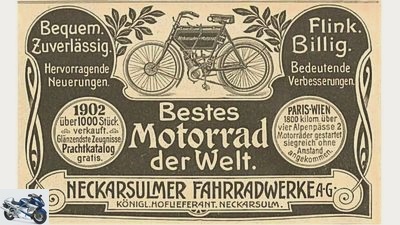
simplicissimus.info
An advertisement from the “Radel-Nummer” of the satirical magazine “Simplicissimus” from 1903: NSU was already producing on a large scale.
Between 1850 and 1900, the number of well-trained skilled workers in Germany had grown exponentially, and it continued to rise. The breadth and depth of knowledge gained through this brought a true high culture of metalworking with it.
Bicycles, weapons and sewing, knitting and typewriters – most of the companies that started to manufacture motorcycles came from these segments of mechanical engineering. That is obvious; They had the greatest experience in handling high-quality materials and extremely precise, because miniaturized components, as required by motorcycle technology. Because even the four-cylinder engines with a larger displacement, the Laurin & Klement and FN from 1905 and Henderson from 1911 on the market were quite delicate constructions. Perhaps this is an explanation for the fact that even in this early phase, when specialization was not yet so advanced, it was difficult to unite under one company roof. There have been many automobile manufacturers who have tried motorcycle production and vice versa, but the majority of these endeavors have been abandoned.
The velocipede was a sensation in the country
Rapid urbanization went hand in hand with industrialization. In 1871 there were eight cities in the German Empire with over 100,000 inhabitants, in which 4.8 percent of 41.1 million Germans lived. In 1910, 21.3 percent of the 64.9 million Germans now lived in 48 large cities with over 100,000 inhabitants. The urban transport area does not exactly suit the dynamics of motor vehicles, but as focal points of communication, large cities ensure the rapid and massive dissemination of new developments. In the case of motorization, it was also the industrial companies involved in this area that drew a large number of workers to the cities and thus kept this topic constantly present in the urban public.
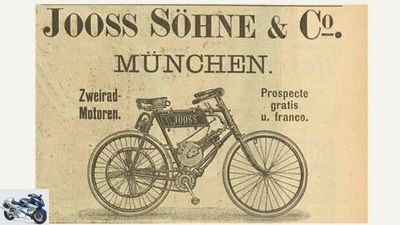
simplicissimus.info
Jooss Sons was a lesser known manufacturer of built-in motors.
Other typical urban phenomena of the time were also beneficial, such as the time management practiced in the course of industrialization and the general acceleration of existence, which began with the rationalization of work processes and quickly spread to other areas of life. Although the rural population had to cover greater distances in less well-developed infrastructure, they ran after the urban population when it came to using engines and other machines to get around. Anne Steck, born in 1912, vividly remembered her youth in the Swabian village of Wimsheim: “Back then it was still a sensation when a velocipede drove through the village. We children all ran after him. ”In the beginning, even hostility towards cyclists, cars and motorcyclists was not uncommon in the country; However, this resistance could not stop the motorization.
The motorcycle and all other forms of motorized locomotion would hardly have been adopted with this intensity if they had not also met a widespread need for mobility. In the second half of the 19th century, bicycles and trains had brought broader sections of the population to faster, more convenient, and more flexible ways of traveling than had ever been possible before. It was therefore easy to convey to many people what further increases in speed and energy savings motorized vehicles would bring. It was not without reason that the editors included a travelogue in the first edition of “Das Motorrad”.
The Munich doctor and writer Felix Schlagintweit, who owned a motorcycle as early as 1901, vividly described this aspect of motorized locomotion in his book “A Life in Love”: “At first, but only for one year, I was enthusiastic about a motorcycle from the Fabrique Nationale in Liège , obtained from the then sole authoritative company Beibbarth. My brother Oskar, with whom I had just opened the small urological clinic at the Max Monument, also bought the same vehicle. I still feel our extreme amazement when we rattled out to Schleissheim in thirteen minutes and calculated an hourly speed of sixty kilometers … When the season in Bruckenau approached, I drove the three hundred and eighty kilometers to Bruckenau on one day through the blooming spring. I can still see the petals swirling up around me from the street strewn with them in Franconia, rich in fruit trees. So you start small, but soon things are too slow for you, if you can at all; because mostly it doesn’t work at all. You go to Beibbarth again, and then you can go again, but you often go until you don’t go anymore because you can. At least that’s how it went with the motorcycle. But as early as 1902 I bought an Oldsmobile, a real car on four wheels … “

simplicissimus.info
In 1903 Metzeler was still building tubular tires with a bead.
Schlagintweit’s puns with “go” indicate how precarious the situation of the motorcycle as a pure means of transport was from the start: Those who could afford it and find no other stimulus on the motorcycle beyond mobility soon switched to the car – a behavioral pattern which could be observed again later in the development phases after the two world wars. When Germany suffered a steep economic downturn in 1907 after a five-year period of boom and the sale of motorcycles was hindered by a “luxury expense tax” introduced in 1906 and a motor vehicle tax from 1907, the development of the motorcycle, which had just begun, suffered a drastic break.
Heinrich Kleyer, the boss of the Adler company, should be mentioned as a representative for many others, who gave up motorcycle construction and dedicated himself solely to the automobile. Not without a vigorous polemic against the tax, which probably wasn’t the sole reason for his decision. It was not until 1949 that the Frankfurt company started building motorcycles again. Triumph in Nuremberg stopped manufacturing motorcycles from 1908 to 1913. Paul Forster, the publisher of “Das Motorrad”, reacted and undertook “a complete reorganization of the magazine”. At the beginning of 1907 he called it “Das Automobil” and described it in the sub-line as a “Community organ for motorcycles and motor vehicles”, three months later it was renamed again to “Der Motor”. The continuation of the magazine beyond 1907 is still unclear, but highly unlikely.
The second wave: 1918 to 1939
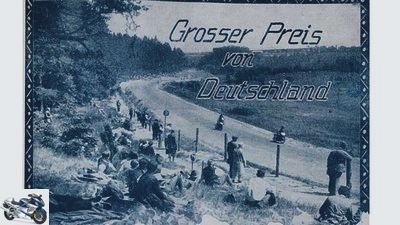
cutter
The enthusiasm for racing in the 1920s.
The number of motorcyclists and registration drivers deployed by the armies involved in World War I was low, the proportion of four-wheeled motor vehicles, especially trucks, was considerably higher, but by no means predominant. Especially in the theaters of war in the east with their difficult infrastructure, horse-drawn carts proved to be less susceptible to motorized means of transport. Accordingly, they were used frequently. Nonetheless, military service has brought more people into contact with all types of motorization within four and a half years than would have happened in the continued state of non-war – the term “peace” is inappropriate given the political tensions in Europe and the aggressive one German nationalism in 1914.
These people, socialized in terms of engine technology as it were through the World War, to whom the many women employed in ammunition factories also tend to be included, formed the target group for the new or restarted motorcycle production in the 1920s. Once again, the big cities and, among them, Berlin in particular, proved to be the living space in which the lifestyle of large sections of the population picked up at an enormous pace. The dynamism of the 1920s is not only tangible in the increasing motorization or the onset of a real boom in car and motorcycle races, but also exemplarily in the enthusiasm for jazz that originated in the USA. Not to forget extremely fast dances like the Charleston, which demands considerable coordination and physical fitness from its dancers with up to 75 four-quarter beats per minute.
The Nurburgring was inaugurated in 1927
In France and Italy, the fascination with speed had already manifested itself more conspicuously before the First World War – for example in the photographic work of Jacques Henri Lartigues or in the futuristic manifesto of the Italian Ernesto Tommaso Marinetti, which appeared in the French magazine “Le Figaro” in 1909: “We declare that the glory of the world has been enriched by a new beauty: the beauty of speed.” Inhibited by war and post-war chaos and therefore delayed, the Germans were now able to develop their sense of the “beauty of speed”.
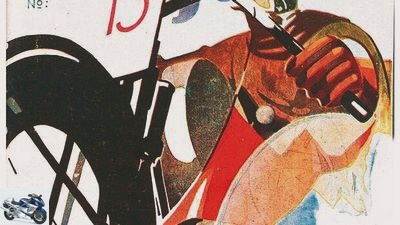
archive
In the course of the 1920s, “Das Motorrad” changed from an engineering magazine to a general-interest magazine.
The “Automobile Traffic and Practice Street” in Berlin, known as AVUS for short, appears like a symbol for this, a pure high-speed railway with two long straights and loop-like connections at their ends. Begun in 1913, left unfinished in 1914, it was completed and opened in 1921. In 1924, planning began for the Nurburgring, which was inaugurated in 1927. In 1921 the time had come to re-establish the magazine “Das Motorrad”; it was now published in Berlin by various publishers, and from 1924 by Konig Verlag.
An economic prerequisite for increasing supply and demand in the motorcycle sector was the continuation of the monetary policy pursued since the beginning of the war. It sought to reduce the real cost of war for the state through moderate and controlled inflation. In the fourth volume of his German history of society, the historian Hans-Ulrich Wehler vividly described how the continued effect of inflationary mechanisms in the first post-war years facilitated the reintegration of returning soldiers, alleviated social conflicts and even increased the average real income by promoting and thereby promoting optimistic economic assessments generated growing employment and even wage increases. Although the investigation of what-if questions is not part of the historian’s business, Wehler even dares to argue in this context that the Weimar Republic perished from its beginnings as a result of a deflationary austerity policy as an alternative to controlled inflation.
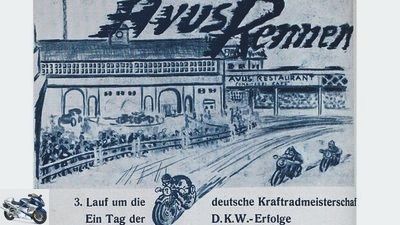
cutter
The legendary race tracks of the 20s.
The example of the Bayerische Motorenwerke – BMW -, which started producing motorcycles under its own name in 1923 as a newcomer, shows another condition for the second wave of motorcycle production in Germany: The numerous armaments factories had to switch to peace production and because of the restrictions develop new products that the Treaty of Versailles imposed on them. At BMW in Munich, in addition to the hope of being able to manufacture aircraft engines for civil aviation, the stock of parts and the means of production for their manufacture were also literally smashed. The BMW workers themselves had to destroy them under the supervision of Allied inspectors.
The grenade detonators, which gave the Zunder-Apparatebau GmbH in Nuremberg the first part of its name, were no longer in demand for the time being. Company owner Fritz Neumeyer therefore decided in 1921 to start developing and building motorcycles. The list of new or re-established motorcycle manufacturers in the early 1920s could be significantly longer than the one from the beginning of the century. For the sake of clarity, in addition to BMW and Zundapp, only DKW should be mentioned here, a company that has left deep, but now almost blurred, traces in motorcycle history.
The forerunner of DKW, founded in the vicinity of the mechanical engineering stronghold of Chemnitz and moved to Zschopau in 1906, managed to become the world’s largest motorcycle manufacturer within a decade. With the construction of grenade detonators and with military orders, the Zschopauer Maschinenfabrik also got through the First World War and retained the abbreviation DKW as a protected brand name from the development of a “steam power car”. From 1919, when the first auxiliary bicycle motor (“Das kleine Wunder”) was produced, the Zschopau plant quickly developed a whole series of motorcycles, mostly with smaller cubic capacities, all of which were powered by two-stroke engines.
The number of motorcycles exceeded that of passenger cars
Going beyond the actual company history, DKW is thus the object of demonstration par excellence for the motorization of the Weimar Republic, the way in which people’s accelerated attitude towards life and their need for mobility were brought onto the streets: on motorcycles that had to be as cheap to buy and maintain as possible . Due to the political and economic turbulence of the time and benefited from the tax exemption for motorcycles up to 200 cm³ displacement from 1928 and the repeal of the driving license requirement for this vehicle class a year later, the so-called small motorcycles in particular paved the German “Sonderweg in die Automobilgesellschaft” – The historian Frank Steinbeck chose this formulation as the subtitle of his book “Das Motorrad”, an extremely knowledgeable scientific work on the history of motorcycles in Germany.
While the number of motorcycles in the German Reich exceeded that of passenger cars from 1926 and until after the Second World War, the opposite occurred in Great Britain in 1924, the USA played the pioneering role in the automization of the masses in those years, and in France too In relation to the total population, around three times as many citizens have a car as in Germany. It was only after the Second World War, in the wake of the economic miracle, which was not a miracle but was perceived as such, that the mass production of the automobile in the Federal Republic of Germany began to develop similarly to that in the countries mentioned 30 years earlier.
It seems reasonable to assume that during the heyday of motorcycles in the Weimar Republic, for most people, there was a painful gap between the desire for quick, comfortable progress and the reality behind the handlebars of a moped. Even so, today’s reader shouldn’t think that motorcycling was a joyless affair back then, only pursued for the purpose of advancement. As early as the second half of the 1920s, the motorcycle was not only being used to commute to work, but also as a recreational vehicle, as traffic counts on weekends show.
The motorcycle industry came to a standstill in 1939
If we summarize the motorcycle-relevant phenomena during the Weimar Republic – the “fast” attitude towards life, the initially favorable economic development in the second half of the 1920s, the tax and driving license subsidies for mopeds, the increase in motorcycle sport events, the construction of race tracks – and then adding the already completed planning of the motorways, it becomes clear that the National Socialists found the ground well prepared for their motorization and motorsport campaign when they came to power in 1933. Even the term “Volkswagen” comes from the language used by traffic planners in the Weimar Republic.
The National Socialist dictatorship itself achieved only three “achievements”: firstly, the rigorous alignment of as many activities as possible in as many areas of life as possible towards the goal set by Hitler; no less unscrupulous propaganda. People paid a high price for another brief boom in the motorcycle business after the Great Depression at the beginning of the 1930s, a solid technical development of motorcycles and a few internationally recognized records and racing victories.
With the attack on Poland on September 1, 1939 and the beginning of World War II, technical progress in motorcycle construction came to a standstill. The legendary Wehrmacht teams of BMW and Zundapp were soon replaced by the cheaper and more powerful VW Kubelwagen. And the Volkswagen, officially known as the KdF-Wagen, only benefited the population in the form refined by the Federal Republic of Germany. In the memory, this sobering motorization balance of the National Socialist rule is still outshone by the myth of the Silver Arrows and the Tourist Trophy victories of Ewald Kluge in a charge pump DKW and Georg Maier in a compressor BMW.
After 1945
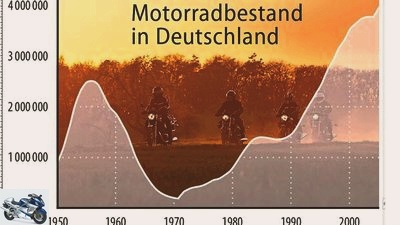
BMW
In the deepest valley of the motorcycle population, the post-war generations found a new passion for motorcycles.
The rebirth of the motorcycle in civil motorization after the Second World War is multifaceted. One of them – the one that can be seen around the world – is aptly symbolized in the DKW RT 125, which is still the most frequently copied motorcycle in the world, although not the most built. It satisfied part of the demand as Komet 125 and Moskva M1 A in the USSR, as Harley-Davidson Hummer or 125 S in the USA, as BSA Bantam in Great Britain, as IFA RT 125 in the GDR and under its original type designation in the Federal Republic of Germany of inexpensive and reliable means of mass transport, and as the Yamaha YA-1, it even stood at the beginning of motorcycle production by what is now the second largest manufacturer in the world.
Another facet of the German motorcycle renaissance after World War II is a national phenomenon that only took shape in a similar form in Great Britain. Hundreds of thousands of World War II veterans in the USA turned the motorcycle into a vehicle of rebellion after the “Hollister Riots” in 1947 in a fascinating interplay of discrimination and aggressive appropriation of discriminatory terms (“1-percenter”), which they reversed in their thrust. The reawakening affinity for motorcycles in Germany was completely different: a politically conservative attitude worked together with a return to long-practiced traditions of machine design, optimization, production and maintenance that had been cultivated since the industrial revolution and that were only confused by the two world wars, but by no means broken.
A huge potential of manual skills and engineering creativity also unfolded in motorcycle construction and met a millionfold, fascinated audience. Even if we look at the traditional number of 400,000 spectators at the first German Grand Prix for motorcycles after the war, in 1952 at the Solitude-Ring near Stuttgart, and the similarly huge numbers of other races of that time, one thing remains undisputed : Motorcycles and motorcycling attracted much larger crowds than they do today.
Better a Volkswagen than a motorcycle
But the same people who were enthusiastic about the top products in racing technology and identified with heroes like Werner Haas, who won three world championship titles at NSU in 1953 and 1954, dreamed of something different for themselves than motorcycling. Eugen Schneider, the author’s father, born in 1940, speaks of it with the same catchphrase as many others of his generation: “We wanted to have a roof over our heads while driving.” Apparently the possible experience of hardship and destruction had created a deep need for security . The Volkswagen, which was gradually getting started, served this need better than the fastest and finest motorcycle could have, which most could not afford anyway.
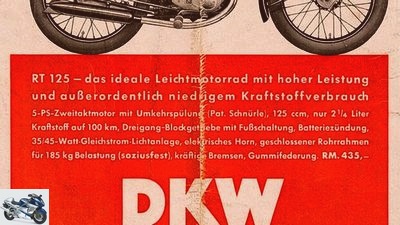
archive
An advertisement from 1940: The DKW RT 125 was fully developed, it was initially only used in the service of the Wehrmacht.
When they faced the alternative VW or NSU with increasing prosperity, most preferred to pay more money for a VW. In the second half of the 1950s, the sales and even the inventory of motorcycles plummeted. Obviously, thousands of the machines bought in the years before were deregistered, put in barns or even scrapped. And with a few exceptions, the German manufacturers dropped their motorcycle division like hot potatoes. After several motorcycle-driven attempts, which were repeatedly interrupted by wars, political unrest, inflation and mass unemployment, the Federal Republic of Germany had finally arrived at the car. In this respect, the mass motorization of the 1920s was not completed until the mid-1950s.
Paradoxically, the high level of craftsmanship and engineering in Germany contributed to cementing the decline of the West German motorcycle industry; motorcycle production in the GDR was spared this decline only because it had barely increased in height when it began. The COMECON states were largely isolated from imports from the West, and massive dismantling – the former DKW works in Zschopau had been emptied twice by the Soviet command – had slowed the recovery of the domestic vehicle industry. The shortage kept the demand alive even for technically backward motorcycles.
Technical complexity at West German manufacturers
If you look at the designs that West German manufacturers brought onto the market in the 1950s and early 1960s, their technical complexity becomes apparent. Not because there were many complex multi-cylinder and multi-camshaft engines, but because even apparently simple two-stroke engines were comparatively difficult to assemble. An example: vertically split engine and gearbox housings of the type used in German 1950s small motorcycles, required axial play to be measured and set to the nearest hundredth of a millimeter.
The housing had to be dismantled and reassembled again to insert the shims required for this. Comparable, but later designed Japanese engines with one fixed and one laterally movable crankshaft bearing could simply be screwed together after the shafts had been inserted; this avoided errors and saved time and production costs. Precisely because there were so many highly trained mechanics in Germany, there was no need to simplify the designs for technical reasons, and when the motorcycle economy picked up again in the 1970s after the depression of the 1960s, the few who were still active were Germans Manufacturers have long since lagged behind in terms of technology and production logistics.
From the 1970s onwards, only Japanese manufacturers were able to offer high technical standards at low prices. Only a small proportion of this was due to excessively high wages in Germany; The main reasons for this were neglected investments in development and rationalization. The motorcycle seemed dead, no longer a product worth investing in. So it was the Japanese manufacturers who reinvented it. And it was the first post-war generations that reinvented themselves in relation to the motorcycle. The term “motorcycle as a recreational device” plays down the meaning of this change too much, the idea of the motorcycle as a vehicle of rebellion projects too much of the American into the German motorcycle renaissance between 1970 and the turn of the millennium. Most of those who had been born manageably shortly after, but with their backs to World War II, were simply traveling to different destinations than their fathers. And with other vehicles.
Related articles
-
archive 22nd pictures archive 1/22 … many Kreidler RS wore expressive golf green. archive 2/22 … One of his first candidates in 1935 was a 600 BSA….
-
Schulz to travel Motorcycle world tour Motorcycle world tour 50,000 kilometers home Many dream of the great journey, the trip of a lifetime. At some…
-
Motorcycle transport solutions Caravans, mobile homes, trailers, transport systems Herder to travel Motorcycle transport guide Motorcycle transport guide…
-
Scene: motorcycle legends and their situation today
MZ Sports & scene Scene: motorcycle legends and their situation today Scene: motorcycle legends and their situation today What are actually doing……
-
Nine short biographies about German motorcycle brands
archive 10 pictures NSU 1/10 What happened to you Biographies of German motorcycle brands. fact 2/10 Excellent workmanship, small, handy and fast: Adler…
-
Motorcycle production at Bimota
Jahn counselor traffic & business Motorcycle production at Bimota This is how one of the smallest manufacturers in the world produces Motorcycle…
-
The small ABC of motorcycle types, part 1 A ?? D.
Buell motorcycles The small ABC of motorcycle types, part 1 A ?? D. The small ABC of motorcycle types, part 1 A ?? D. ETV 1000 XB9R S4R Manufacturers…
-
Japan – a motorcycle manufacturing nation
MOTORCYCLE 15th pictures MOTORCYCLE 1/15 Japan’s motorcycle builder Honda 2/15 Like on the assembly line? In Japan – as here at Honda with the Africa…
-
Motorcycle production, part 1: Honda
Jahn 15th pictures Jahn 1/15 How are motorcycles produced? Where do the parts come from, what happens before final assembly? These questions urged…
-
Manufacturer statements on the subject of motorcycle noise
Motorcycle noise Debate about the volume of motorcycles Astrid Gast – stock.adobe.com counselor traffic & business Manufacturer statements on the subject…